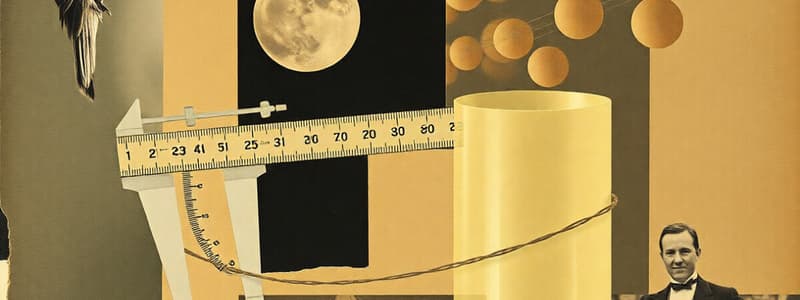Podcast
Questions and Answers
What is the least count of the vernier caliper?
What is the least count of the vernier caliper?
- 0.02 mm (correct)
- 0.1 mm
- 0.5 mm
- 0.01 mm
What is the range of the vernier caliper mentioned?
What is the range of the vernier caliper mentioned?
- 0 - 180 mm
- 0 - 150 mm (correct)
- 0 - 200 mm
- 0 - 100 mm
If the main scale division equals 1 mm, what does this imply for measurement accuracy?
If the main scale division equals 1 mm, what does this imply for measurement accuracy?
- Low accuracy as there are fewer divisions
- High accuracy due to small divisions (correct)
- Exact measurement is not possible
- Moderate accuracy based on larger divisions
How is the zero error typically measured?
How is the zero error typically measured?
Which of the following functions does a vernier caliper NOT perform?
Which of the following functions does a vernier caliper NOT perform?
What is the radius of the cylinder calculated from the given data?
What is the radius of the cylinder calculated from the given data?
What is the height of the cylinder as per the calculations?
What is the height of the cylinder as per the calculations?
What is the formula for calculating the curved surface area of the cylinder?
What is the formula for calculating the curved surface area of the cylinder?
What is the volume of the cylinder calculated based on the given dimensions?
What is the volume of the cylinder calculated based on the given dimensions?
What value corresponds to the average diameter of the cylinder?
What value corresponds to the average diameter of the cylinder?
Which value represents the curved surface area of the cylinder after calculation?
Which value represents the curved surface area of the cylinder after calculation?
In the volume calculation, which value was used as the height of the cylinder?
In the volume calculation, which value was used as the height of the cylinder?
What unit is the volume of the cylinder expressed in?
What unit is the volume of the cylinder expressed in?
Flashcards are hidden until you start studying
Study Notes
Experiment Aim and Setup
- This experiment aims to measure the diameter and height of a cylinder using a vernier caliper and calculate the curved surface area and volume of the cylinder.
- The vernier caliper used has a range of 0 - 150 mm, with a least count of 0.02 mm.
- The caliper has both internal and external jaws for measuring internal and external diameters.
- It also includes a depth measuring blade.
- The tool features a metric scale and an imperial scale.
- The vernier scale has 50 divisions.
- The main scale has divisions of 1 mm.
Observations
- The experiment involves recording the main scale reading and the vernier scale reading that coincides with a mark on the main scale.
- The vernier scale reading is then multiplied by the least count to find the vernier scale reading in millimeters.
- The final reading is obtained by adding the main scale reading and the vernier scale reading.
- The experiment records two readings of the diameter for accuracy and calculates the average.
- The experiment records three readings of the height and then calculates the average.
- The experiment measures the zero error of the vernier caliper, which is the difference between the zero mark on the vernier scale and the zero mark on the main scale.
- The experiment calculates the correction (C) for the zero error.
Calculations
- The radius of the cylinder is calculated by dividing the diameter by two.
- The curved surface area of the cylinder is calculated using the formula: A = 2πrh, where r is the radius and h is the height.
- The volume of the cylinder is calculated using the formula: V = πr²h, where r is the radius and h is the height.
Results
- The experiment concludes with the calculated values for the radius, height, curved surface area, and volume of the cylinder.
- The results are reported in centimeters.
Studying That Suits You
Use AI to generate personalized quizzes and flashcards to suit your learning preferences.




